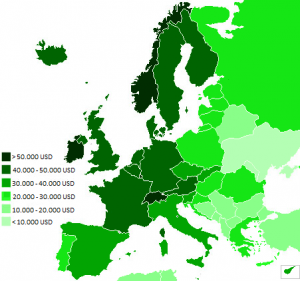Can Europe be driven in a multispeed mode?
Economy 26 February 2017On 23rd of November 1959 in Strasbourg, the president of the newly formed Fifth French Republic, Charles de Gaulle has announced his vision of Europe: “Yes, it is Europe, from Atlantic to the Ural, this is Europe, this is whole Europe, a Europe which will create a world`s destiny”. And indeed, the European project maybe has not defined the destiny of the planet, but in it has significantly contributed to its existence. There is no area of everyday political life in which the influence of the most ambitious project hasn`t left its mark.
Also, there is no continent, nor country towards this supranational entity hasn`t been establishing its foreign relations with. From the Economic Community, along with the other “communities”, the EU has managed to create an area in which people, capital, services and goods can travel freely among its member states. This project has attracted many European countries beside the “big six” (France, Germany, Italy and Benelux states), and in 2013 it has had it latest enlargement, when Croatia became the 28th member state of the European Union.
The path from six to twenty eight was very long. It was very hard to achieve this level of integration not only in political but in the economical sense as well. The most visible part of economic integration of the EU is Euro area which involves 19 EU member states. It is clear that some of the states are not involved in Euro currency system. The European project isn`t going as perfect as it had been planned. What are the key specifics of the economic integration and what are the consequences of the long integration process? Can Europe be driven in a multispeed mode?
New world`s currency, the Euro was introduced in January 2002. So far, most of the EU member states have accepted Euro within their financial systems. There are 19 member states of the Eurozone. However, not all of them are accurately developed.
The EU has experienced several enlargements. The biggest one occurred in 2004, when 10 new member states entered the full membership regime. After that, the EU family became bigger for three new members: Bulgaria and Romania (2007) and Croatia (2013).
The latter member states are far less developed than the founding members of the Union. The first 15 member states of the “club”, hereinafter “old Europe”, are more rich and developed than the new members of the club “newcomers”.
This analysis will be based on the macroeconomic indicators comparing the old Europe with the newcomers. The first macroeconomic indicator, the GDP per capita could clearly emphasize the different level of economic development between the old Europe and the newcomers. Nominal GDP list for 2016 is also indicating the same thing: out of all newcomers, the best ranked is Czech Republic with 167 billion EUR, and is placed on 16th place.
The euro area accounted for 70.6 % of the EU-28’s GDP in 2015, down from 72.0 % in 2008. In 2015, the sum of the five largest EU Member State economies (Germany, the United Kingdom, France, Italy and Spain) accounted for 67.6 % of the EU-28’s GDP (which was identical to their share a decade before in 2005).
The first „big“ five EU member states (Germany, France, Italy, Spain and UK) have in total bigger nominal GDP than all other member states of the Union. It is very interesting to mention the so-called NUTS regions. Those are the regions of the EU based on the statistical merit. The NUTS1 regions are the ones with the highest GDP. What makes this issue important, is the fact that in the last 13 countries which joined the EU (2004, 2007 and 2013), only Prague and Bratislava came into the “club” of the NUTS1 regions, or “the most developed ones”.
The ten biggest companies within the EU are located in only 5, out of 28 countries: Germany, France, UK, Netherlands and Italy.
In the previous short analysis it is shown what`s the difference between the old Europe and the newcomers through the presentation of macroeconomic indicators. But are there any more problems the newcomers face with? Yes. Most of the newcomers did not accept Euro as their official currency yet. Some of them are Hungary, Slovenia, Poland, Czech Republic, Croatia, Romania…The list is not exhaustive, but the EU is not fully economically integrated entity.
Purchasing Parity Power (PPP) varies in extremely different sides. For instance, salary in Germany, France and the other parts of old Europe is in some cases 10 times higher than in the fresh newcomers Bulgaria and Romania. The rivalry between the old and new is also visible in the four freedoms. Bulgarian and Croatian workers can freely move and legally work in Britain from 2021, while the case for Romania is 2019. Over the first decade of the XXI century, Britain has faced with the “plumbers inflow”, from Poland. Many of Polish plumbers entered the UK, which triggered the British parliament to adopt a decision on the opt-out of the freedom of labour for foreign citizens, which should be a subject of negotiation with each country willing to join the EU.
The European project is surely the most unique idea the world has ever seen. The peace and prosperity has been provided to the half of billion of inhabitants. If treated as one single country, the European Union would have been the second world`s economy power. That is why it needs to work more to cooperate with the less rich member states in order to achieve the equal level of development.

World Bank database


